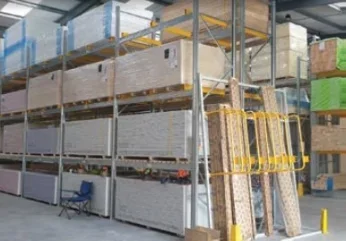
Proper material handling and storage is core to both efficiency and health and safety in a modern timber merchant, and in the majority of cases gone are the days when warehouses and yards were disorderly and hazardous.
In fact, as a SEMA approved racking inspector (SARI) and a recently qualified SEMA approved cantilever inspector, I can honestly say standards around handling and storage have come on leaps and bounds over the past decade, with far more robust procedures in place to protect staff, customers, and plant and equipment.
However, one area where there is still work to do is in the handling and storage of nonpalletised materials such as plywood sheets.
In my role as a racking inspector and sales director of Filstorage, I often visit merchants who store such materials at height in a hazardous way, not understanding the dangers such materials present.
But with a few minor changes, this can be easily remedied, helping to optimise safety for staff and customers, and reduce damage to racking.

FORKLIFT ACCESS
The main issue with storing non-palletised sheeting materials on pallet racking concerns forklift tine access once the products have been opened.
As all merchants will know, when bounded together, such materials have wooden spacers at the bottom to enable forklift truck tines to get in so they can be safely lifted on to racking.
Often these wooden spacers are only held in place by the banding straps that hold the products together, meaning once the product is opened, they fall away.
This can cause issues with handling open non-palletised products, and also with their storage, and in my experience has prompted some merchants to introduce an unnecessary risk into their otherwise strong safety procedures.
For example, incidents of unsecured wooden struts being placed directly onto the pallet racking beams so long items can be stored on top of them are common.
But this causes a major hazard for warehouse and yard operatives, and customers, because it only takes a knock from a forklift to send them crashing to the ground. They can easily be dislodged when retrieving products at height, as well, posing a further danger to people below.
What is worse, we have even heard of incidents where staff have climbed racking to put these struts in place or to move them around to suit different products, again, posing a huge health and safety issue.
Any merchant where this takes place can expect serious reprimands if the worst ever comes to pass.
SECURING NON-PALLETISED PRODUCTS
So, what is the best way to handle open, non-palletised products so they can be safely loaded onto a forklift and securely stored on racking?
The first thing to consider is whether you actually need to store timber sheets or similar products at height in the first place. Is it possible to have these products lower down? If so, this is the safest option.
But if not, then finding ways to store nonpalletised products at height safely has to be your number one priority.
For this, we would recommend fork entry bars, also known as fork clearance bars or fork spacers.
Fork entry bars are essentially racking support bars that make storing non-palletised items on pallet racking much safer. They are a relatively inexpensive investment, so it still surprises me how few merchants have installed them.
Fork spacers attach securely to racking beams to provide space for forklift tines to get under the product and lift it safely, eliminating the chance of makeshift spacers being knocked from the racking.
They also provide structural support for the load and guidance for forklift tines, allowing for quicker and more secure handling, and they can be altered to fit different sized sheeted materials. As they are securely attached, they do not need yard or warehouse operatives to climb the racking to alter them.
If alterations are needed, they should be carried out by a properly qualified individual.
So effective are fork spacers, we discuss them as an option on all new pallet racking enquiries for timber merchants as a matter of course to help them optimise health and safety for their workforce.
However, they can also be retrofitted to existing racking, meaning timber merchants struggling with storing non-palletised products in a safe way can, with a small investment, significantly improve their handling and storage capabilities.
Storing products at height will remain a hazardous but entirely necessary activity. It is the merchant’s responsibility to ensure that their staff and customers are as safe as they can possibly make them.
Relatively small and inexpensive solutions such as fork spacers on racking beams can make a huge difference to the overall safety of a warehouse or timber yard.





